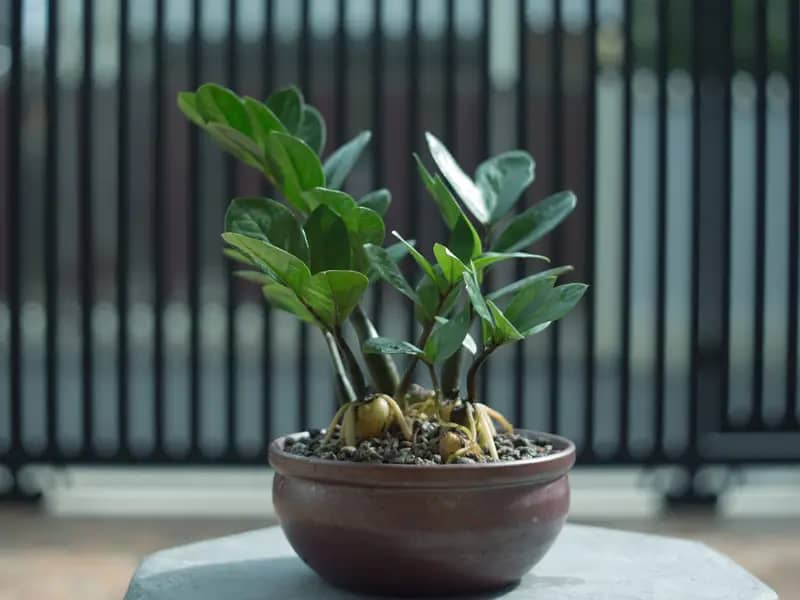The ZZ plant (Zamioculcas zamiifolia), often referred to as the Zanzibar Gem, is a popular houseplant known for its striking appearance and low maintenance requirements. This guide will provide an in-depth look at the Zanzibar Gem, including its description, how to grow and care for it at home, common plant diseases, and their solutions, as well as synonyms.
Description
Plant is native to Eastern Africa, particularly Kenya and Tanzania. It features glossy, dark green leaves that grow in a symmetrical pattern along thick, upright stems. The plant can reach up to 3 feet in height, making it an excellent choice for both small and large indoor spaces. One of the standout features of the Zanzibar Gem is its ability to thrive in low light conditions, making it perfect for offices and homes with limited natural light.
- Scientific Name: Zamioculcas zamiifolia
- Common Names of this plant: ZZ plant, Zanzibar Gem, Eternity Plant
- Height: Up to 3 feet
- Light Requirements: Low to moderate light
- Watering Needs: Low, drought-tolerant
- Soil: Well-draining potting mix
How to Grow and Care for ZZ Plant at your Home
Light Requirements
ZZ plants are incredibly adaptable and can tolerate a wide range of light conditions, from low to bright indirect light. However, they do best in moderate to bright indirect light. Avoid placing the plant in direct sunlight, as cause the leaves to scorch.
Watering
One of the reasons Zanzibar Gem are so popular is their drought tolerance. They have rhizomes that store water, allowing them to go for long periods without watering. Water your Zanzibar Gem thoroughly, allowing the soil to dry out completely between waterings. Overwatering can lead to root rot, so it’s essential to ensure the pot has good drainage.
Soil
Select a well-draining potting mix for your ZZ plant, such as one formulated for succulents or cacti. Make sure the pot has drainage holes to prevent water from accumulating at the bottom.
Temperature and Humidity
ZZ plants prefer average household temperatures between 65-75°F (15-24°C). They can tolerate lower humidity levels, making them suitable for most indoor environments. Avoid placing our plant near to cold drafts and heating vents.
Fertilizing
Fertilize your Zanzibar Gem once or twice a year during the growing season (spring and summer) with a balanced, water-soluble fertilizer. Over-fertilizing will cause the leaves to become leggy and weak.
Repotting
ZZ plants have a slow growth rate and don’t need frequent repotting. Repot your ZZ plant every 2-3 years or when it becomes root-bound, using a pot that is 1-2 inches larger in diameter than the current one.

Plant Diseases and Solutions
You Can buy This Plant Online: Buy Here
Root Rot
Symptoms: Yellowing leaves, mushy stems, and a foul smell from the soil.
Solution: Reduce watering frequency or ensure your plant pot has proper drainage. If the plant is severely affected, remove it from the pot, trim the rotting roots, and repot in fresh, well-draining soil.
Leaf Spot
Symptoms: Brown or black spots on the leaves.
Solution: Remove the affected leaves and enhance air circulation around the plant. Avoid getting water on the leaves, and apply a fungicide if needed.
Yellowing Leaves
Symptoms: Leaves turning yellow.
Solution: This can be caused by overwatering, underwatering, or low light. kindly adjust your watering schedule and remember move the plant to a brighter location if needed.
Synonyms
The ZZ plant is known by several synonyms that highlight its unique characteristics:
- Zanzibar Gem
- Eternity Plant
- Emerald Palm
- Aroid Palm
Incorporating these keywords will help improve your article’s visibility and attract readers interested in learning about the ZZ plant.
By following these guidelines, you can enjoy the beauty and low-maintenance qualities of the ZZ plant in your home. Happy planting!

